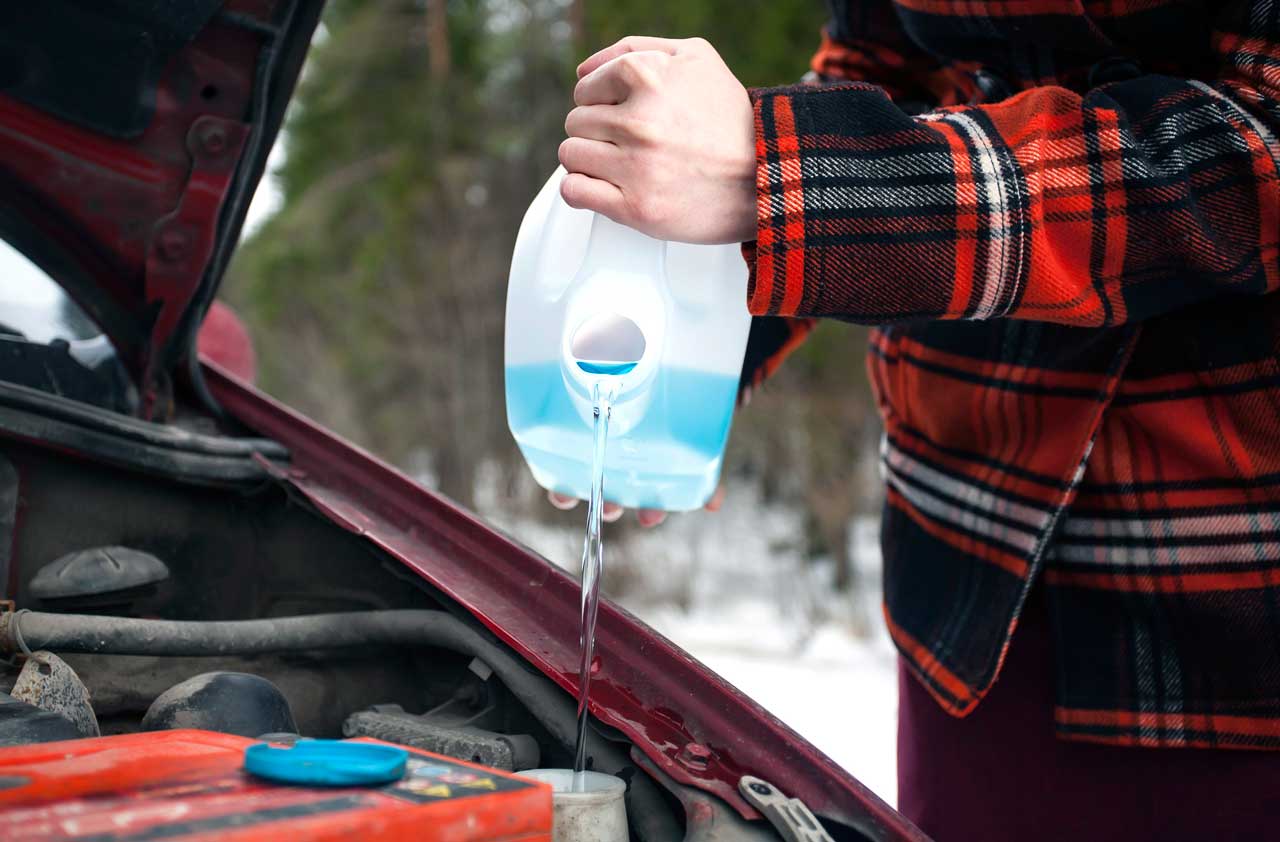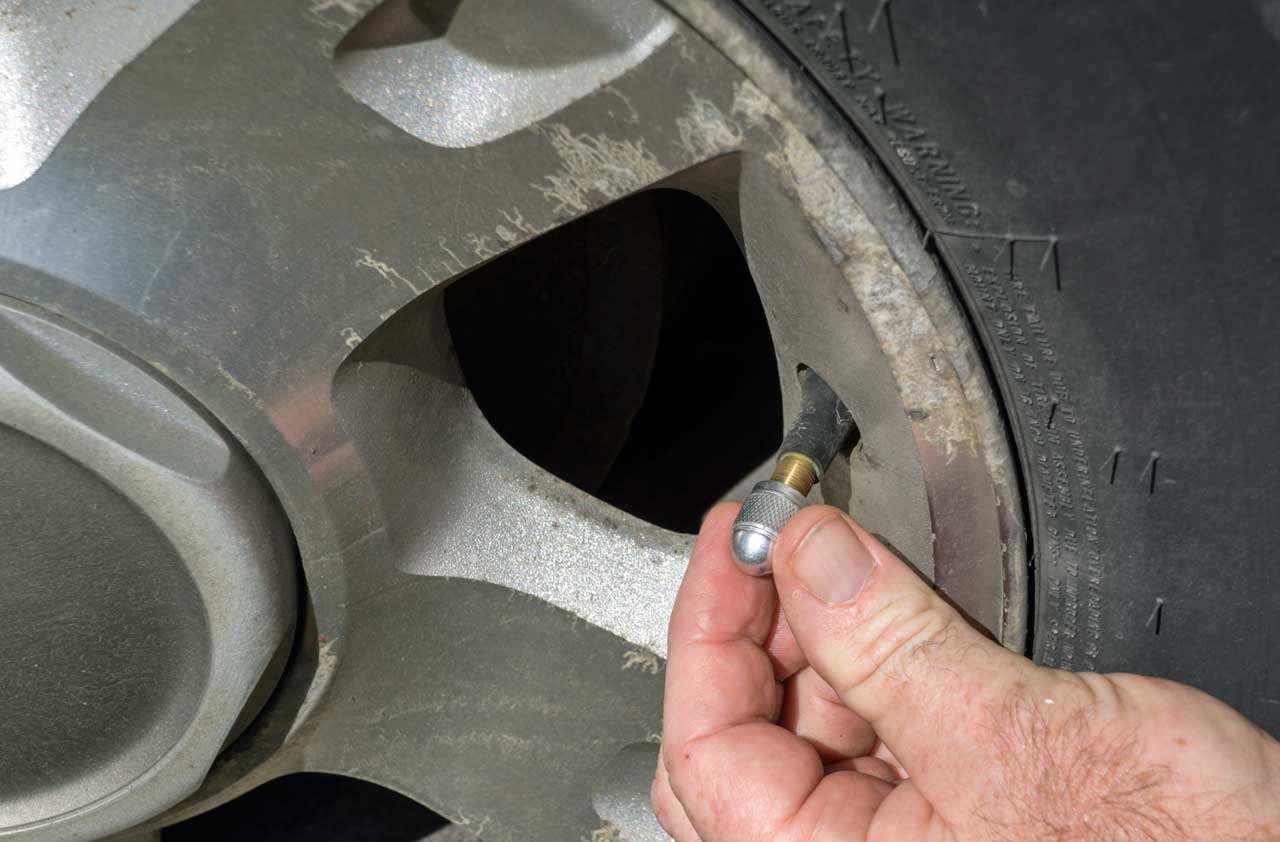11 Winter Car Maintenance Tips
Cold temperatures put stress on your car. Get ahead of the situation and keep winter woes from hurting your ride or your wallet.


Perhaps the first frost has already coated your windshield, or the tire pressure warning light came on for no apparent reason (also a sign of winter—we’ll explain more). As you zip up another layer, give a thought to your ride, and check out these eleven tips that will keep your car rolling smoothly and safely through the cold season’s challenges. Even old salts might find some new insights.
We’re assuming you’ve covered the basics (such as that scraper; try under the seat?) and are up-to-date on your car’s regular scheduled service. Don’t postpone that—a mishap that might be just an annoyance in warmer weather could be a life-endangering hazard in the winter.

Tires for Winter (Or, Winter Tires?)
We’ve been evangelizing winter tires—yes, that means an entirely separate set of tires mounted on their own wheels just for the colder months—for a long time. Curious about our sermon? Read Why Winter Tires Trump All-Wheel Drive.
But we also want to acknowledge a new-ish contender for better winter grip, the all-weather tire, also called the premium traction tire, depending on who you talk to. Now, an all-weather tire is not the same thing as an all-season tire; most tires get the all-season designation, to the point that it’s a largely meaningless term.
An all-weather tire is designed to have decent snow grip without compromising performance (or durability) the rest of the year. So, you only need one set. They will have the three-peak snowflake symbol (3PMSF) on the sidewall, meaning they’ve passed a test for more snow traction under acceleration. “3PMSF-branded tires make a good single-tire choice for drivers who live in transitional regions, where they may see some snow and inclement weather but not enough to necessitate a dedicated winter tire,” says TJ Campbell, tire information and testing manager for online vendor Tire Rack. “If you have only ever used all-season tires and you’re not going to buy a dedicated winter tire, they will likely feel very good. They’re not a substitute for a dedicated winter tire, though.”
The snowflake symbol isn’t the whole story, though, and so finding yourself all-weather tires means wading through a lot of marketing talk. We’re going to cut through some of that and recommend (in part because Tire Rack does, as does Consumer Reports) the Michelin CrossClimate2; it was one of the pioneers of this winter-capable but not winter-dedicated niche. Other examples: Goodyear Assurance WeatherReady and Vredestein Quatrac.
Whatever you choose for tires, make sure there’s enough tread on them as you head into winter. Getting through snow requires the deepest grooves possible, and worn tires on which you might have gotten away with in summer will put you into the ditch when the white stuff falls. See if you have enough with this coin-based test.

Don’t Make Compost in Your Car
As you tackle fall’s bounty on your lawn, leave some energy for removing the leaves that find their way into your vehicle.
Leaves, twigs and other organic matter can cause havoc with gutters on your house—and the equivalent on your car. When debris builds up in areas of your car where water is supposed to run out, you can get leaks or corrosion.
The air plenum near the windshield is a classic spot where this can happen.
If you have a sunroof, open it up and look around in there, too, from outside the car. Sunroofs have drains to flow water that sneaks past the seals down and out of the car. Plant gunk in there can plug those drains, making for wet headliners, wet carpets or worse.
Less common, but more problematic: Animals may make nests under the hood, storing nuts or, worse, gnawing wires. You may need a mechanic and an animal trapper to fully solve this problem.

Get Your Wipers Ready
Fog, snow and rain will cut down your visibility in winter. Your ability to keep the windshield clear will be tested.
Once upon a time, people in colder climates fitted “winter blades” that had rubber boots over the metal frames to keep them from freezing up. These are rarely needed, as most cars from the last decade have a type of blade, often called “beam blades”, that aren’t as prone to the freezeup.
However, these blades have gotten darned expensive. While replacing wiper blades annually was once recommended as a matter of course, many will blanch at the cost. One way to get more life out of a pair is a wipe down with window cleaner, vinegar or rubbing alcohol. Saturate a rag you’re willing to part with and scrub hard both ways up and own the rubber part of the blade. You’ll see a lot of black stuff come off: That’s dirt and dry rubber, and your blades should do a better job with it gone. Of course, cleaning the windshield itself is part of the deal.
Some folks pop their wipers up when they park so they’re not touching the windshield if freezing stuff is in the forecast. This little trick can make it easier to scrape your windshield. Some folks believe this wears out the spring in the wiper arm and risks windshield damage if wind or some other force knocks the blade down abruptly. Parlor debate; we’re staying out of it.

Is Your Battery Fully Juiced?
Winter puts more stress on your battery, particularly if you park your car outdoors.
Avoid the sinking feeling of hearing nothing when you hit the ignition with a proactive check of your battery and charging system now. Repair shops don’t usually charge very much to load-test your battery, and some car parts stores will do it for free.
If you find out your battery’s going south, you can replace it at your convenience, instead of being at the mercy of whatever shop your dead car’s been towed to. Note that some big-box stores such as Costco offer a good price on batteries for those of you willing to change one yourself (not usually all that hard, though batteries are heavy).

Survey Your Nethers
To improve aerodynamics and save fuel, today’s cars are equipped with increasingly elaborate underbody panels and low-hanging air dams.
These can be vulnerable to damage any time of year, but driving over a snowdrift in the winter could turn a small problem into a more expensive one by ripping off the entire panel and maybe its mounting hardware.
So before the ground’s too chilly to lie on, take a look under the car, starting from the front, to see if there’s anything loose hanging down or flapping about. Maybe you can just pop it back into place. Maybe a zip tie will take care of it, or even duct tape.

Stop — Or at Least Slow — Corrosion
Vehicles’ resistance to corrosion has come a long way in the last few decades, for Japanese brands in particular, which in the 1970s and 1980s were known to dissolve after a couple of salty winters. But as Neil Young reminds us, rust never sleeps.
Give the car a good look-over (preferably after a wash, in daylight) for any scratches or dings where the damage goes through the paint—that is, you can see bare metal underneath. These need some paint on them as soon as possible, before road salt starts getting in there and making a small problem far worse. Obviously, professional repair is most effective, but if that’s not in the budget, you can effect a quick fix yourself:
The most basic approach is simply to clean the area with some kind of solvent (acetone, rubbing alcohol, whatever) and slap some clear coat on there (even nail polish will do). Even fancier: buy touch-up paint in your car’s color and use that. You can get more elaborate, of course—as well as come back and do a better job in the spring.
As for stopping rust to the underbody, the best thing you can do is to keep it clean with regular washing. If you’d like to take it up a notch, the rustproofing business is still alive. You can consider a professional application (that might require annual touchups), or get a product like Fluid Film (non-toxic—it’s made with sheep-wool grease, of all things) and spray a few cans on the metal bits of your underbody. Did you spot rust already forming when you checked your nethers? Well, you can fight back.

Check the Antifreeze
This is many people’s first thought when it comes to winter car care. “Flush and fill” promotional signs still pop up at service stations as the weather cools.
But chances are good your engine coolant (a better name for it) is just fine for the winter ahead. If you’ve followed your car’s service schedule regularly, give this pitch a pass. Most newer cars have been fitted with coolants that can last as long as five years or 150,000 miles—or forever. Check your owner’s manual.
If you’ve missed a service interval or have another reason to doubt your coolant, go ahead and have it “flushed and filled.” Just make sure your mechanic uses a compatible coolant to refill your car.
If you have moved to (or are planning to visit) a much colder climate and you’re concerned that your coolant might not be up to the deep freeze, you can check its effectiveness with a simple, under-$10 tester from the car-parts store.

And Check the Washer Fluid
Have you been putting plain water in the washer fluid tank? Maybe just a little? Whether you were trying to be green or cheap, this is a bad idea, even if you live where freezing is not much of a concern. It can lead to (no, really) Legionnaire’s disease.
Having your watery mélange freeze up (and expand) in the reservoir and tubes of your washer system could obviously be costly, but even if you avoid that fate, diluted fluid is more likely to freeze when it’s sprayed out of the jets and onto the windshield. If you’re traveling somewhere where it gets wicked cold, pay attention to the label of the washer fluid. Some formulas have lower freezing points than others. Give yourself a safe margin; there are few things more annoying (or dangerous) than having your windshield frost over completely while you’re driving (it’s happened to me).

Don’t Forget to Put Winter Air in the Tires
Okay, we’re joking. There’s no such thing. But since physics is still in charge, cooler temperatures have an effect on your tires. John Paul, the "Car Doctor" for AAA Northeast, sees the following scenario often: You start your car on a cold morning and the tire pressure warning light comes on. You drive off anyway (tut tut) and later in the day, as you’ve logged some miles, maybe parked in the sun, the light goes back out.
Problem solved? Nope. “Tires lose a pound of pressure for every drop of 10 degrees fahrenheit,” explains Paul. “So, if you inflated them on a beautiful 75-degree day, and then two weeks later, it’s 41, that’s three pounds of air.” Couple that with the fact that tires lose about a pound or two a month anyway, and that could be why the light is coming on now. The solution to keeping the light from coming back is, of course, to top up your tires to the manufacturer’s specifications—when the tires are cool. A properly inflated tire, Paul adds, also won’t vary as much in temperature as one that’s underinflated.
While we’re on the topic of underinflation. You may have heard the guidance to let air out of your tires for sand or snow to get more surface area touching the road and thus more traction. That only applies only if the surface is bottomlessly soft, like a beach or foot-deep, unplowed snow—not the mix of cleared road, ice and packed snow most of us encounter in winter driving.
Don’t forget to put the valve caps back on when you’re done (and replace any cracked or missing caps with new ones). If moisture gets in there and freezes, it could let the valve core leak out air.

Add a Survival Kit (of Some Sort)
Everyone should have a space blanket in the car, tucked in the glove compartment or some other storage space in reach of the driver.
The most complete survival kit in the world won’t do a bit of good if you’re in an upside down car you can’t get out of and the kit’s in the trunk. That’s the scenario you could be looking at if you, say, slid off an embankment in a snowstorm on a desolate road. It might be a while before help arrives.
The shiny space blanket’s ability to keep you warm could be a lifesaver. It takes up virtually no space and costs less than $10.
Next things we’d add:
•Whistle
•Plastic bag for gathering snow for water
•Plumber’s candle & lighter
•Single-edged razor blade (to cut up your upholstery for insulation)
•Empty metal soup can (for melting snow with the candle)
You can—and perhaps should—keep going, maybe some snacks, a small flashlight, a backup power source for your phone? (Some people suggest packing a wordy novel.) The more rural and remote your roads, the more you’ll want stashed.
Check out a thorough approach from the folks at the North Dakota Department of Transportation—they know snow and ditches.

Wax the Lights
Okay, we admit it’s a little detail, but in winter’s gloom, every last lumen you can squeeze out of your headlamps is going to improve your safety.
Here’s an easy two-minute drill: Make sure the headlamps are clean of dirt, then rub car wax (any type will do) on the lens. Let it dry and buff it off. Repeat. For bonus points, do the taillights.
The slippery surface you leave behind will be less likely to build up an “icicle” coat when road slush refreezes on your car—and will make it easier to remove it if it does.
Get Kiplinger Today newsletter — free
Profit and prosper with the best of Kiplinger's advice on investing, taxes, retirement, personal finance and much more. Delivered daily. Enter your email in the box and click Sign Me Up.

In his former role as Senior Online Editor, David edited and wrote a wide range of content for Kiplinger.com. With more than 20 years of experience with Kiplinger, David worked on numerous Kiplinger publications, including The Kiplinger Letter and Kiplinger’s Personal Finance magazine. He co-hosted Your Money's Worth, Kiplinger's podcast and helped develop the Economic Forecasts feature.
-
 80-Year Old Dick Durbin, the Senate’s No. 2 Democrat, To Retire After 44 Years in Congress
80-Year Old Dick Durbin, the Senate’s No. 2 Democrat, To Retire After 44 Years in Congress‘In my heart, I know it’s time to pass the torch,’ Senator Durbin said in a statement.
By Kathryn Pomroy
-
 Stock Market Today: Stocks Rise on Good Volatility
Stock Market Today: Stocks Rise on Good VolatilityInvestors, traders and speculators continue to process the "known unknown" of global tariff-and-trade war negotiations.
By David Dittman
-
 What to Do With Your Tax Refund: 6 Ways to Bring Growth
What to Do With Your Tax Refund: 6 Ways to Bring GrowthUse your 2024 tax refund to boost short-term or long-term financial goals by putting it in one of these six places.
By Rachael Green
-
 What Does Medicare Not Cover? Eight Things You Should Know
What Does Medicare Not Cover? Eight Things You Should KnowHealthy Living on a Budget Medicare Part A and Part B leave gaps in your healthcare coverage. But Medicare Advantage has problems, too.
By Donna LeValley
-
 15 Reasons You'll Regret an RV in Retirement
15 Reasons You'll Regret an RV in RetirementMaking Your Money Last Here's why you might regret an RV in retirement. RV-savvy retirees talk about the downsides of spending retirement in a motorhome, travel trailer, fifth wheel or other recreational vehicle.
By Bob Niedt
-
 The Six Best Places to Retire in New England
The Six Best Places to Retire in New Englandplaces to live Thinking about a move to New England for retirement? Here are the best places to land for quality of life, affordability and other criteria.
By Stacy Rapacon
-
 The 10 Cheapest Countries to Visit
The 10 Cheapest Countries to VisitWe find the 10 cheapest countries to visit around the world. Forget inflation woes, and set your sights on your next vacation.
By Quincy Williamson
-
 15 Ways to Prepare Your Home for Winter
15 Ways to Prepare Your Home for Winterhome There are many ways to prepare your home for winter, which will help keep you safe and warm and save on housing and utility costs.
By Donna LeValley
-
 Six Steps to Get Lower Car Insurance Rates
Six Steps to Get Lower Car Insurance Ratesinsurance Shopping around for auto insurance may not be your idea of fun, but comparing prices for a new policy every few years — or even more often — can pay off big.
By Donna LeValley
-
 How to Increase Credit Scores — Fast
How to Increase Credit Scores — FastHow to increase credit scores quickly, starting with paying down your credit card debt.
By Lisa Gerstner
